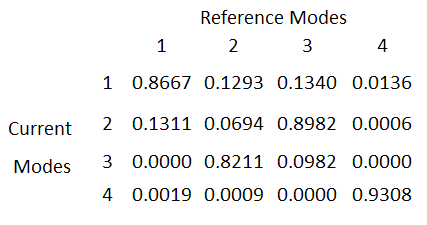Mode Tracking | ||||||
|
| |||||
The mode tracking feature cannot be guaranteed to work properly for all examples due to the large material changes during topology optimization.
The modes of the different eigenfrequencies are compared in the modal
assurance criterion (MAC) for identifying if the eigenfrequencies
from optimization iteration to optimization iteration have been switching
yielding:
where the initial modes are equal to the modes of the first iteration. Here, i are the reference modes and j modes in the optimization iteration. The modes in the first optimization iteration are used for identifying the eigenfrequencies through the optimization iterations.
The MAC matrix is equal to the unity matrix if the initial modes are equal to
the modes in a given optimization iteration. However, this is only the
case in the first optimization iteration due to the optimization changes.
The largest components of the MAC matrix are determined in each
optimization iteration for determining if any mode switching should
be present. If significant off-diagonal terms exist in the MAC
matrix, it indicates that the mode switching is present. The MAC
matrix is printed in the TOSCA.OUT file. Then the user can see how close
to 1 the components of the MAC matrix are and whether mode switching
is present. If all the values in the MAC matrix are significantly
below 1, it indicates that the applied mode set does not contain enough
modes for mode tracking.
According to the above equation, mode tracking can lead to a significant increase in CPU-time. First, all modes of the eigenfrequencies must be cross-checked with each other. Sometimes a high number of cross-checks is required. Second, more eigenfrequencies must be calculated by the finite element solver.
During the optimization, the MAC Matrix can look like the following:

Mode tracking is defined in OPT_PARAM command as in the example
below:
OPT_PARAM
ID_NAME = opt_params
OPTIMIZE = id_of_optimize
MODETRACKING = ON
MODENUMBERS = 15
END_
Setting the command MODETRACKING equal to ON activates the mode
tracking. Default for MODETRACKING is OFF.
Consequently, mode tracking will only be applied if the user requests
mode tracking.
The value of MODENUMBERS specifies how
many eigenfrequencies should be used in the mode tracking. The default
value of mode tracking is 5. In the above example, MODENUMBERS
is set to 15 meaning that 15 eigenfrequencies will be used for the mode
tracking. If, for example, one maximizes the first eigenfrequency, this eigenfrequency
will be compared to the 15 specified eigenfrequencies in the MODETRACKING
command. It is important that the modal analysis file specified by the
user also leads to an analysis having the same or more eigenfrequencies
than specified in the MODENUMBERS command. For this example,
the user should specify at least 15 eigenfrequencies in the finite element
file.
Sometimes it happens that many local modes having a low eigenfrequency appear during the
optimization iterations. Normally, this will lead to high number for
MODENUMBERS, which is not desirable because of high CPU-time. However, this
can be partly circumvented by setting a number in the input finite element file avoiding the
lower eigenfrequencies to be calculated. For example, if it is known that the initial eigenfrequency
is around 200 Hz, then it should be specified in the finite element input file that the
eigenfrequencies over 50 Hz only are to be calculated.
To improve the performance, it is additionally possible to restrict
mode tracking to a certain group of nodes in the model (for example, every
fifth node on the surface of the model) or nodes where lumped and rigid
masses are attached. In this case, the node group is referenced in the
MODETRACKING parameter as follows:
OPT_PARAM
ID_NAME = opt_params
OPTIMIZE = id_of_optimize
MODETRACKING = ON, node_group
MODENUMBERS = 15
END_
When a node group is applied in the mode tracking, then the modal assurance
criterion (MAC) yields:
where the modes are not scaled with the mass. Therefore, the nodes of the applied group are often chosen to be the nodes of frozen elements, lumped, or rigid masses.
Important:
|